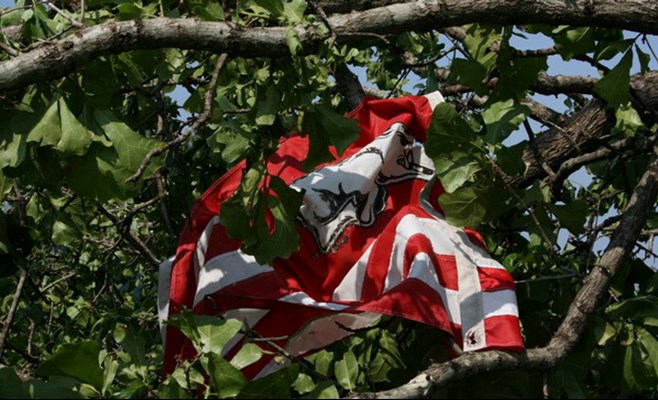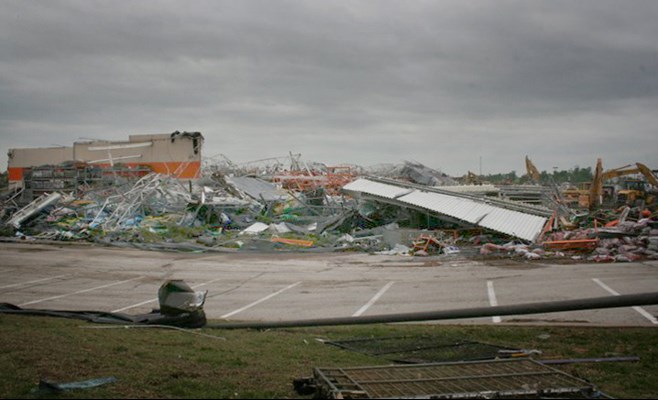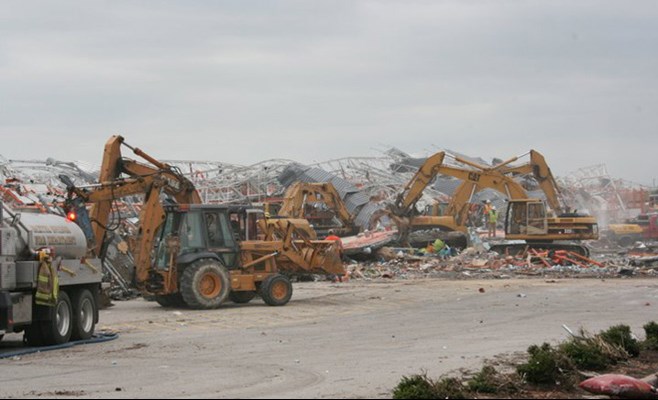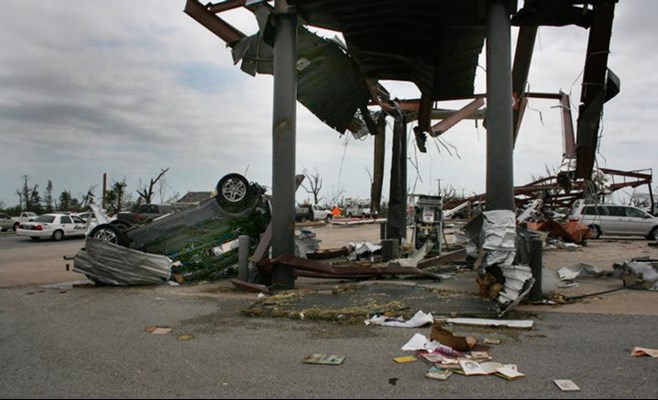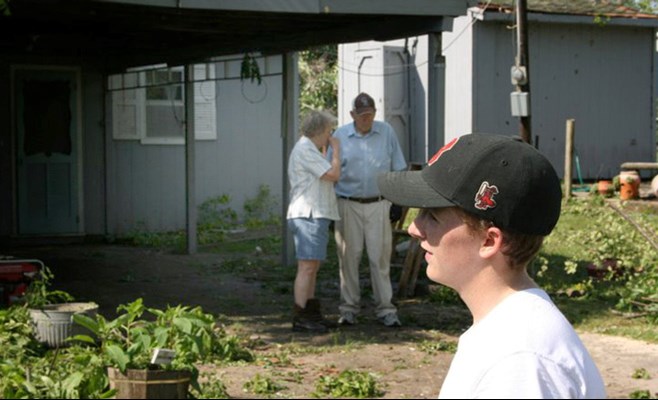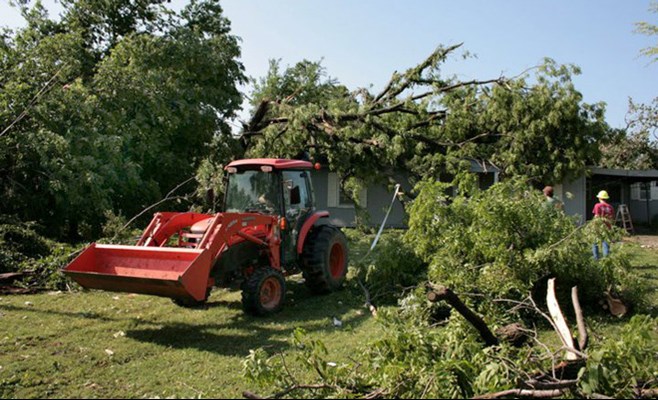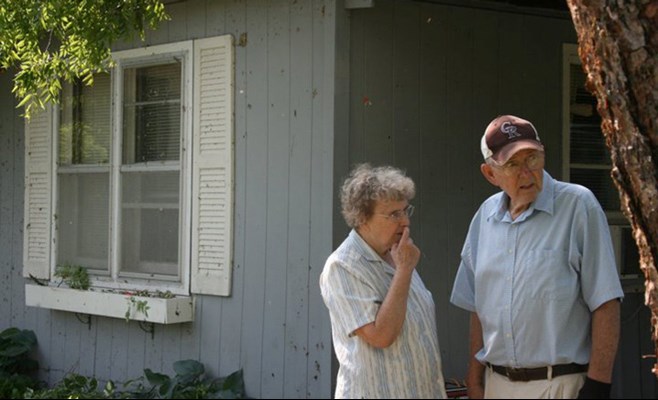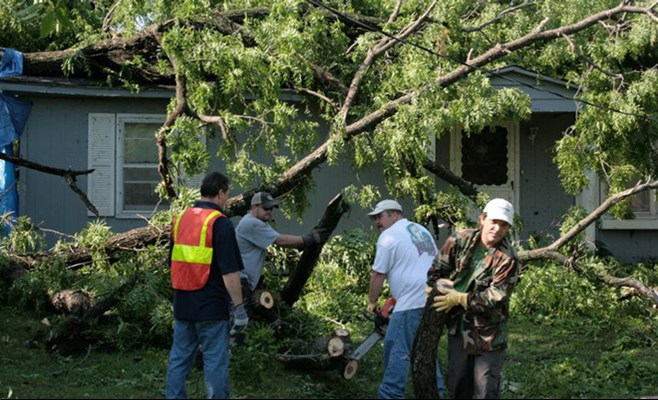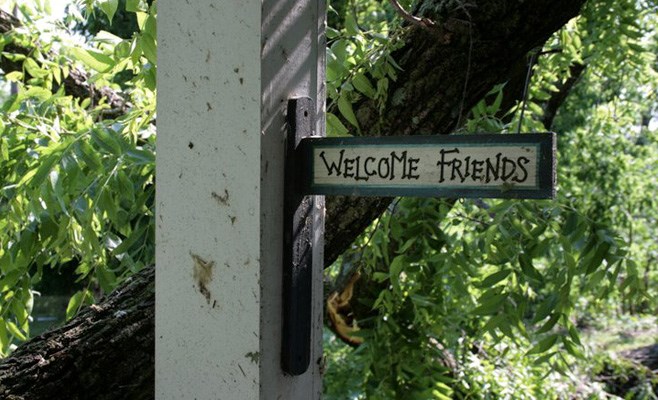Dispatches from Joplin

Blocks of Joplin, Mo., were swept away by a tornado on Sunday, leaving more than 100 dead and thousands without shelter.
University relations research writer Matt McGowan grew up in Joplin, and Monday he went home to make sure his parents, brother, relatives and friends were safe. He visited his old neighborhood and sent these pictures and impressions.
Monday afternoon, May 23
Despite a severely swollen Shoal Creek, the back roads worked until I reached 32nd and Main, 12 blocks south of the vague route of the tornado that ripped through Joplin 24 hours ago. My brother thought I might be able to make it to 18th and Main, where he was helping a friend secure a business, but police were not allowing non-emergency vehicles north of the chaotic intersection.
I turned right on 32nd. All roads leading north and hugging Main were blocked. I drove six, maybe eight blocks, before I could turn left and enter the war zone. As I moved north, the gravity of this storm slowly came into view. I weaved around mangled cars, downed power lines and fallen trees. Stunned residents walked aimlessly up and down Ohio and Kentucky and Missouri, anonymous streets in an otherwise anonymous, middle-class neighborhood. Some residents huddled in roofless garages. They were the lucky ones. Six blocks later, at 26th and Kentucky, the landscape looked like Bonn or Dresden after Allied bombings. I had no idea where I was. And I grew up here.
The twister roared through this area and scorched everything. Some houses collapsed; others evaporated.
Thinking I could still make it back to Main, I turned left on 26th, although I had no idea what street I was on because all the signs were missing. I kept driving west until traffic stopped. Again, I had no idea where I was. I only vaguely knew that Main Street was somewhere up ahead. But then I saw the Taco Bell and realized I was there, at Main already, but there was nothing other than the fast-food restaurant to prove it.
I looked up ahead. Weirdly, surreally and faraway, I saw St. John’s Hospital, the one my brother was born in, the one where several patients died yesterday due to the tornado. That’s odd, I thought. You’re really not supposed to see that building from here.
I was done driving. I could see that I would get nowhere, so I doubled back and parked at 28th and Ohio. (Grateful the sign was there.) I parked and got on my bike. I pedaled north and saw more destruction. As I approached 20th Street, the vague channel of the tornado, I sort of recognized a large structure on my right. By this time, I must have crossed three-dozen downed power lines. I figured if I was going to get electrocuted, it would have already happened. The large structure was Joplin High School. Rolling along, I looked over to my right. Most of the gymnasium, where I’d played basketball in high school, had imploded. Some of it was missing entirely.
On the other side of the street, opposite the high school not a single house stood. The whole block was gone. Nothing but rubble.
I made it to 18th and Main, where my brother was waiting for me. We loaded the bike in the bed of his truck and drove east. He wanted to show me Parr Hill Park, where we’d played as kids. We parked and rode again, weaving through city blocks until we got back to 20th, which we crossed to reach what my brother called the “epicenter.” We kept riding, and on the south side of Parr Hill Park, I had to stop. All I could do was cry. I jumped up on a concrete park structure to shoot some pictures. My brother was below me. He pointed and said, “There used to be a house there.” I looked across the street and saw a clean slab foundation, nothing else.
It was pouring rain.
Monday night
The stories here are bizarre and hideous.
One man died while lying on his wife to protect her. She lived.
A friend of mine went fishing with his wife on Sunday. On the way home, their son called to tell them about the tornado watch. My friend and his wife turned on the radio and heard that a tornado had touched down in Galena, Kansas, only five miles west of Joplin. They stopped to get gas at the intersection of 32nd and U.S. 71. They walked inside the station and did not leave until the roof had been torn off. When they went outside, a gas pump was on top of their Mitsubishi, which also had a three-inch hole in one door. Later, their son came upon a car with a street sign poking out of it. The sign had killed a woman inside the car.
Most people do not want to leave their homes, even if the actual structures no longer exist. They guard and watch. Fear is in their eyes. They want to hold on to what’s left. My parent’s friend won’t leave her home, despite major structural damage. She slept in her bathtub Sunday night.
While eating tonight, my brother mentioned a friend who lives at 25th and Joplin Avenue. Or used to. Not until then did I realize that her home was only a block away from the intersection that I did not recognize earlier that day, despite having been there probably 800 times in my life.
Had anyone heard from her? I panicked. I remembered approaching the nearby intersection of 26th and Main, where there was nothing but flattened buildings, smoke and piles of debris. In the chaos and geographic disorientation, I had forgotten about my friend. Later Monday night, I found out she was okay. She was home Sunday afternoon and decided to go to the mall to buy a dress for a graduation ceremony. While shopping, the tornado roared in from Kansas and wiped out her house.
For a while, people on the outside knew more than people close to the damage and destruction, because power and cable television were out. My friend in Kansas City had more information about the extent and magnitude of the storm than his mother had, and she lives only six miles from the nearly mile-wide path of flattened buildings and twisted aluminum siding wrapped around toothpick sycamores.
Disabled technology and more than a little fear prevented my mother from watching news reports. She lives in Webb City, roughly seven miles north of the tornado’s wrath. She also abhors human suffering. When my brother showed her a video on CNN.com, she shook her head and cried. Her emotional state did not improve when she later discovered that one of her students, a four-year-old girl, and the girl’s father, were missing.
My niece and nephew, who are 13-year-old twins, begged their father to take them out of school, so they can help with the rescue and cleanup. He said no once, and then again and again. But he wasn’t frustrated with them. There is a palpable sense here that everyone is grateful to be alive and surrounded by those they love.
The twins told us about one of their classmates who attended school on Monday, despite the fact that her parents had not come home Sunday night. The girl was cared for by an 18-year-old sibling. Monday night, more than 24 hours after the tornado had struck, their parents still had not returned.
Something came to mind late at night. Two people mentioned the same thing to me today. After viewing the damage firsthand, they both said they believed.
Tuesday, May 24
There is a low hum around here, a strange, ambient buzz interrupted – or perhaps created – by the high-pitched whining of chain saws, the ubiquitous chugging of portable generators and the rhythmic thwacking of two helicopters circling the destruction zone. Backhoes and front-loaders growl, their knobby tires gripping and roaring against the asphalt surface of roads leading to the crippled home of Jim and Ruth Millard. The Millards live on 22nd between Kenser and Reinmiller, less than a mile east of the god-awful intersection of 20th and Rangeline.
My brother and a man I don’t know are cutting up a large hickory that fell on the Millard’s house. The rest of us on are on the ground, waiting for them to throw branches down, so we can load them on top of one of the four already-large piles of brush and chopped-up tree. The Millards are here, trying to contact their insurance adjuster and still wondering how they survived. “We had one years ago,” Jim says, “but it wasn’t like this.” Ruth wants to know how much this will cost. I assure her the cleanup will cost nothing, that we’re all volunteers, that all we want to do is take that big tree off her house. She is nice. She and Jim ask us if we need water.
Hank, the Millard’s 16-year-old grandson, is here too. He lives in a house about the length of a football field away from his grandparents. They ran down into their basement when they heard the tornado coming. His ears popped. Others felt nausea. Then they heard a load roar and hard thudding against the house. Hank’s mother Carol said it was difficult to breath in the basement. When the tornado hit, Hank said, it sounded like washers and dryers were slamming up against the back of the house. His mother concurred. She came up from the basement because she thought the tornado had passed, but the storm cranked up again real fast, and she saw large objects – about the size of washers and dryers – flying by her house.
Grateful to be alive.
“We had some siding tear off,” Carol says, “and there was damage to shingles on the roof. But who cares?”
Aerial views of Joplin show that Sunday’s tornado traveled due east right down 20th Street. I suppose there are more densely populated areas of the city, but I don’t know what they would be. The aforementioned intersection of 20th and Rangeline (U.S. Business 71), where Home Depot collapsed and many people died, is one of the busiest in town. Imagine Joyce and College. The destruction continues east of Rangeline all the way to Duquesne and beyond, but then somewhere east of Duquesne, about three-fourths of a half mile from the mangled heap of steel trusses that once was Home Depot, the tornado veered and headed southeast until it reached Flying J’s, where my friend had hunkered down with his wife and strangers.
I left the Millard’s and rode my bike west on 20th. All along the street, on both sides, there was massive, widespread destruction. Dazed homeowners salvaged items from their homes. Crews from power companies in Oklahoma and Kansas City lined the street. The Oklahoma crew had already erected half a dozen new poles.
I reached 20th and Duquesne, another intersection I’d driven through hundreds of times but did not recognize. I stopped and shot some photographs of a gas station that was reduced to a heap of twisted metal. A woman came up to me and said her daughter managed the store. Twenty people took shelter in a large cooler inside the station, she said. They survived. I looked at the heap and marveled at how that was possible. She said they walked out the back. I couldn’t tell the back from the front or side. All I saw was a collapsed mound of metal and steel. The woman also said that someone shot a home movie from within this building when the tornado hit. She said the video was aired on CNN.
As I continued west on 20th, I saw business owners and employees trying to deconstruct mounds of detritus. There was a place that had to have been a car-repair shop. The building was gone, but an exposed vehicle was still perched on raised hydraulics. The Pepsi distributor was gone. So were other businesses. Gone. No trace at all. Only heaps of twisted metal and broken glass, smashed air conditioners and heating units and tons and tons of wet insulation splattered all over the place.
I made it to Home Depot, which faced Rangeline but was set back maybe 200 yards from the busy thoroughfare. I stopped and took pictures of demolition vehicles lifting rubble off the massive heap of collapsed girders and trusses. This was a busy and eerie place. Search and rescue teams were still searching for missing people. Despite the large construction equipment, it was relatively quiet. Then a police car and one ambulance screamed down Rangeline, and everyone stopped to watch them. The death toll had risen to 116.
I knew it was time to leave. I took a few more photos and then called my mom to get the phone number of a friend I needed to contact. As I was looking at the Home Depot parking lot, my mother told me that her dance student, the little girl who was missing, had died there in a car with her father and brother.
Related story: Campus Relief Efforts
Topics
Contacts
Matt McGowan, science and research communications officer
University Relations
479-575-4246,
dmcgowa@uark.edu
Headlines
Four Students Named Goldwater Scholars; Two Earn Udall Honorable Mentions
Four U of A students have received the prestigious Goldwater Scholarship, an award for top students in mathematics, science, and engineering.
Cross-Campus Collaboration Culminates in New Outdoor Geological Installation
Grand opening event to celebrate the new GeoLab installation at the U of A’s Gearhart Hall courtyard is set for May 3. The installation will be open to the public year-round.
First Students to Use Online Degree to Hone Nursing Leadership, Elevate Patient Care
Hanna Baxendale and Wendi Kimbrell will begin coursework in the Doctor of Nursing Practice-Executive Master of Business Administration program offered by the Eleanor Mann School of Nursing and Walton College.
Join the Office for Sustainability on a Final Cruise to Campus
Cruise to Campus Wednesdays have fostered a gathering space for individuals interested in biking to campus. Drop by the Old Main Lawn from 7:30-10 a.m. Wednesday for coffee, something to eat and conversation.
Fay Jones School Student Ambassador Program Gives Voice to Design Students
The student ambassador program at the Fay Jones School of Architecture and Design is built to connect top design students with their school, its alumni, its future students and others inside and outside the school.
